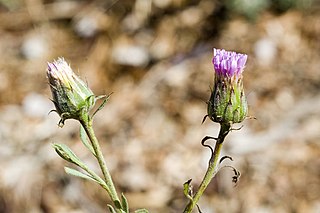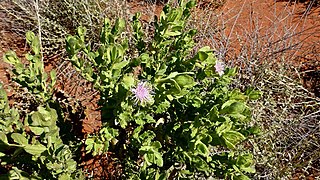
Hovea trisperma, commonly known as common hovea, it is a flowering plant in the family Fabaceae. It is a small straggling shrub with purple-blue flowers and is endemic to Western Australia.

Verticordia halophila, commonly known as salt-loving featherflower, or salt-loving verticordia, is a flowering plant in the myrtle family, Myrtaceae and is endemic to the south-west of Western Australia. It is an erect, bushy shrub with small, crowded, thick leaves and spikes of red and pink flowers in spring.

Frankenia pauciflora, the common sea-heath or southern sea-heath, is an evergreen shrub native to southern Australia. It is part of the Frankenia genus of the Frankeniaceae family.

Spyridium parvifolium, commonly known dusty miller, is a flowering plant in the family Rhamnaceae. It has dark green leaves and clusters of small, whitish flowers at the end of branches. It is widespread in eastern states of Australia.

Olearia phlogopappa commonly known as the dusty daisy-bush or alpine daisy-bush is a species of flowering plant in the family Asteraceae that is commonly found in eastern New South Wales, Victoria and Tasmania. It is a small shrub with greyish-green foliage, daisy-like flowers in white, pink or mauve that can be seen from spring to late summer.

Olearia floribunda, commonly known as heath daisy-bush, is a species of flowering plant in the family Asteraceae and is endemic to south-eastern Australia. It is an upright, spreading shrub with egg-shaped leaves and white and yellow or mauve, daisy-like inflorescences.
Eremophila ciliata, commonly known as Archer's eremophila is a flowering plant in the figwort family, Scrophulariaceae and is endemic to a small area in the south of Western Australia. It is an erect, spreading shrub with short, thick leaves and small lilac to mauve flowers. It is only known from a population of about 100 plants.

Hakea kippistiana is a shrub in the family Proteacea and endemic to Western Australia. It is a dense prickly shrub with sharp needle-shaped leaves with fragrant white, cream or pink flowers from November to February.

Hakea rigida is a flowering plant in the family Proteaceae with a restricted distribution and endemic to the western Goldfields region of Western Australia. It is a dense shrub with grey bark and sprays of pink flowers in spring.

Hakea subsulcata is a shrub in the family Proteacea and endemic to an area in the Wheatbelt, Great Southern and the Goldfields-Esperance regions of Western Australia. It is an upright, broom-like shrub with needle-shaped leaves and purple-pink flowers from winter to early spring.

Hakea sulcata, commonly known as furrowed hakea, is a flowering plant in the family Proteaceae and is endemic to Western Australia. It is a prickly shrub with grooved, cylindrical leaves, sweetly-scented flowers and relatively small fruit.
Leionema equestre, commonly known as Kangaroo Island phebalium, is a shrub species that is endemic to South Australia. It is a small spreading shrub with rough, green leaves and whitish-pink flowers from late winter to October.

Hibbertia circinata is a species of flowering plant in the family Dilleniales and is endemic to eastern Australia. It is a tall, upright shrub with yellow flowers and broad, dark green leaves. It is a critically endangered species endemic to New South Wales.

Scaevola eneabba is a species of flowering plant in the family Goodeniaceae. It is a small, spreading shrub with fan-shaped white to pink flowers and is endemic to Western Australia.

Streptoglossa decurrens is a species of flowering plant in the family Asteraceae. It grows in Queensland, Western Australia and the Northern Territory. It is an upright, aromatic perennial herb or shrub with pink-purplish or reddish purple flowers.

Streptoglossa liatroides is a species of flowering plant in the family Asteraceae. It is a low, spreading or upright perennial herb with pink or red to purple flowers. It grows in South Australia, New South Wales, Western Australia and the Northern Territory.

Streptoglossa macrocephala is a species of flowering plant in the family Asteraceae. It is a spreading or upright perennial herb with pink to purple flowers. It grows in Queensland, Western Australia and the Northern Territory.

Streptoglossa odora is a species of flowering plant in the family Asteraceae. It is a spreading, perennial herb with pink or bluish-purple flowers. It grows in Queensland, Western Australia and the Northern Territory.

Commersonia apella, commonly known as many-flowered commersonia, is a small, upright shrub in the family Malvaceae and is endemic to Western Australia. It has hairy leaves and whitish flowers.

Frankenia serpyllifolia, commonly known as bristly sea-heath is a flowering plant in the family Frankeniaceae and grows in New South Wales, South Australia, Queensland and the Northern Territory. It is a small, spreading shrub with pink flowers.


















